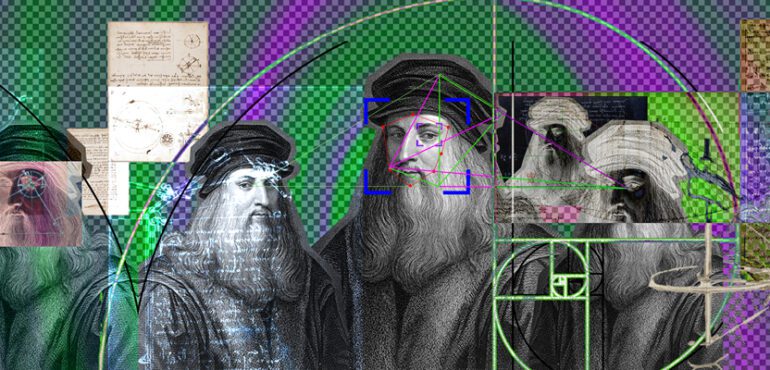TL;DR:
- Google Arts and Culture presents “Inside a Genius Mind,” an innovative online retrospective using machine learning to uncover the depths of Leonardo da Vinci’s brilliance.
- The project collaborates with 28 institutions worldwide and features over 3,000 drawings, including rare pages from the Codex Atlanticus.
- Leonardo’s diverse works in art and science are organized thematically, revealing his boundless creativity and interdisciplinary ingenuity.
- Cutting-edge AI technology allows viewers to explore 3-D models and animations of Leonardo’s inventions, enhancing traditional museum exhibitions.
- The exhibition’s AI-generated “Da Vinci’s Stickies” provides interactive mashups of Leonardo’s sketches, appealing to art enthusiasts and novices alike.
- Google Street View transports viewers to Leonardo’s birthplace and resting place, while delving into his only painting in North America.
Main AI News:
In an unprecedented fusion of art and artificial intelligence, Google Arts and Culture presents a captivating online retrospective that delves into the extraordinary life and works of the Italian Renaissance polymath Leonardo da Vinci. Aptly named “Inside a Genius Mind,” this ambitious project is a collaborative effort involving 28 esteemed institutions worldwide, expertly curated by the renowned Leonardo authority and art historian Martin Kemp.
Awe-inspiring and immersive, the retrospective showcases an astounding array of over 3,000 meticulously preserved drawings, including 1,300 pages of the legendary Codex Atlanticus, a collection of 12 volumes that serves as a gateway to the enigmatic thoughts of the master artist, inventor, and engineer himself. These precious manuscripts, rarely accessible to the public eye, provide an unparalleled glimpse into the profound depths of Leonardo’s intellect, spanning an eclectic range of subjects from science and anatomy to flight and beyond.
Powered by cutting-edge machine learning technology, Google’s team embarked on a monumental mission to unveil the intricacies of Leonardo’s oeuvre. The resulting thematic sections artfully unravel the rich tapestry of his artistic and scientific output, illuminating the interconnected brilliance that defined his genius. “Inside a Genius Mind” is a testament to Google’s unyielding commitment to leveraging technology to create transformative virtual experiences that surpass physical boundaries.
A triumph of innovation and collaboration, the project involved close partnerships with esteemed museums across Poland, Italy, and France. Google’s meticulous scanning of every drawing and the digitization of Leonardo’s fabled wall paintings at the Sala delle Asse, within Milan’s Castello Sforzesco, stand as testaments to their unwavering dedication to preserving cultural heritage.
Not stopping at mere static exhibits, the online extravaganza treats viewers to astounding 3-D models and animations of Leonardo’s ingenious inventions, including his captivating flying machines. The culmination of seven years of work, these visualizations serve to enrich traditional museum exhibitions, enhancing the visitor’s encounter with the maestro’s creations.
Beyond captivating visuals, “Inside a Genius Mind” endeavors to make Leonardo’s narrative accessible to all. Google’s AI-driven “Da Vinci’s Stickies” generate playful mashups of the artist’s sketches, offering an interactive and engaging experience to art enthusiasts and experts alike, all from the comfort of their homes.
Transporting audiences on a digital odyssey, the retrospective whisks viewers to the very roots of Leonardo’s inspiration – his birthplace and even his final resting place – through the immersive Google Street View. Notably, the exhibition also provides an in-depth exploration of the sole Leonardo painting housed in North America, “Ginevra de’ Benci” at the National Gallery of Art in Washington, D.C.
Amit Sood, the visionary founder and director of Google Arts and Culture, remarks that Leonardo’s boundless diversity of accomplishments will undoubtedly astound and inspire viewers. In Leonardo’s sketches, disciplines converge seamlessly, underscoring the polymath’s unparalleled ability to merge creativity with science and art with innovation.
Conclusion:
Google’s groundbreaking AI-powered retrospective of Leonardo da Vinci’s genius mind represents a compelling intersection of technology, art, and history. By leveraging machine learning, Google has successfully brought together an extensive collection of Leonardo’s works, making them accessible to a global audience. This immersive exhibition not only preserves cultural heritage but also sets a precedent for how AI can transform the way we engage with art and historical figures. For the market, this signifies a growing potential for AI-driven virtual experiences and collaborations between technology companies and cultural institutions, creating new opportunities for the dissemination of art and knowledge.

